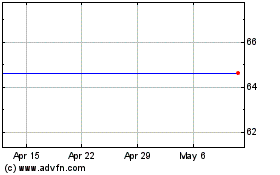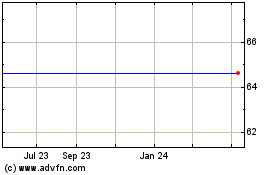IHS Markit Hurricane Update (September 13, 2017)
September 13 2017 - 9:53AM
Business Wire
Crude Oil, Refining, U.S. Fuels Markets, NGLs and Chemical
Sector Impacts
IHS Markit (Nasdaq: INFO), a world leader in critical
information, analytics and solutions, is releasing periodic updates
on the impact of Tropical Storm Harvey on the crude oil, refining
and chemical sectors.
A summary of the latest update follows below (As of end of day
September 12, 2017).
The complete report is available at http://bit.ly/2eUZilB
Refining
- IHS Markit estimates that 13 of the 20
affected refineries are at or near normal operating rates. Five of
the other seven are actively in the process of restarting or
ramping up runs.
- The amount of capacity offline is still
significant. Including the impact of refineries that are partially
operational, IHS Markit estimates that around 1.7 million b/d of
distillation capacity (9 percent of U.S. total) is offline as of
September 12. This is down from around 4.8 million b/d (27 percent
of U.S. total) at the peak of the flooding.
- Because of the amount of refining
capacity that remains offline (and perhaps Irma-related market
jitters), gasoline prices have been slow to decline. It has now
been nearly two weeks since the peak of Gulf Coast flooding and the
NYMEX RBOB spot price remains about 20 percent above its pre-Harvey
levels.
- Looking forward, gasoline prices may
decline sharply in the coming week due to the arrival of European
product cargoes and Hurricane Irma affecting demand.
U.S. Fuels Markets
- Without another hurricane threat to
U.S. refining, we are now past peak with U.S. gasoline prices.
- The largest declines are likely to come
in the states that saw the greatest late August/early September
spikes. East of the Mississippi markets look to see drops of
perhaps 5-10cts gal per week. The declines are probably set to
begin in earnest with the first day of autumn.
- Sub-$50 bbl crude oil prices would
under ordinary circumstances equate to street prices in the $2.25
gal neighborhood or lower. Gasoline fetches much more than crude at
the moment on worries that at least 1-million b/d of Gulf Coast
refining may be down (post-Harvey) until October.
- In August, we saw at least one week
where gasoline demand was measured at more than 9.8-million barrels
per day. Don’t be surprised to see one of the upcoming September
weeks with demand about 1-million b/d lower. Part of this is
post-Hurricane demand destruction, but part of it is the lumpiness
that tends to lift driving season demand and depress demand during
normal weeks.
- Florida terminals are being resupplied
as we speak. Marathon’s facilities appear to be open throughout the
state and that company has the most extensive network of logistics
in the Sunshine state. Cargoes from Europe took alternate routes to
the East Coast but should soon arrive and Louisiana-sourced
material delayed for 5-7 days is en route to Florida. The problem
may come via lack of ethanol – at least two unit trains did not
make the usual trip from Midwest to Florida locations.
Logistics
- Major Gulf coast ports have all
re-opened although on an individual basis there may be Coast Guard
mandated restrictions that are still being enforced.
- The three major Class I railroads in
the area – Union Pacific Railroad, BNSF Railway and Kansas City
Southern Railway -- have effectively restored service on their
networks, but delays linger. By Sept. 9, Union Pacific Railroad had
reduced the number of miles out of service from 1,750 at the peak
of disruption to 50 miles. KCS and BNSF said their Houston area
subdivisions were all operational. However, service delays are
expected thanks to a backlog of freight and reduced train speed
limits due to repair work.
- Freight demand is returning to Houston,
as immediate emergency relief gives way to longer-term rebuilding
needs. That’s putting more pressure on already rising truck
rates.
- The impact is being felt nationwide.
For the week ending Sept. 2, the U.S. average dry van spot market
rate posted by DAT Solutions, a load board operator, rose 12 cents
to $1.90 a mile. In Dallas, outbound spot truck rates rose 26 cents
per mile. On the Dallas-to-Houston lane, however, spot rates were
jolted upward by $1.60 per mile.
- Higher transportation costs are in the
forecast for any chemical or refined product companies utilizing
truck as well as rail transport for several months.
Crude
- A persistently wide Brent-WTI price
spread is the most telling signal that U.S. crude oil markets need
more time to return to normal in the wake of Hurricane Harvey. The
price differential, about $3 per barrel before the storm, is now
over $6, a sign that U.S. crude oil supplies are increasing surplus
relative to the international market.
- That surplus has emerged as a still
significant chunk of Gulf Coast refining capacity remains offline
(although most facilities are recovering). At the same time, port
and pipeline closures earlier this month has caused a disruption in
U.S. crude oil exports, which dipped to just 150,000 b/d the week
ending September 1st (they had been averaging about 900,000 b/d
year-to-date).
- Last week’s EIA report showed a 4.6
million barrel increase in U.S. crude oil stocks, and there are
expectations for perhaps an even bigger build in this week’s
report.
- Hurricane Irma appears to have had
negligible impact on U.S. crude oil production, although a handful
of platforms evacuated personnel in advance of the storm. As Gulf
of Mexico and onshore production returns to normal, we expect U.S.
overall crude output to surpass its previous 2015 monthly average
peak by the end of the year.
Natural Gas Liquids (NGLs)
- The U.S. Energy Information
Administration (EIA) published the first weekly propane/propylene
inventory post Hurricane Harvey. U.S. propane and propylene
supplies built by 6.3 million barrels over the week ended September
1, according to EIA's Weekly Petroleum Status Report.
- The build, measured over the course of
a reporting week during which Hurricane Harvey decimated large
swaths of the U.S. Gulf Coast, far surpassed the average 3.5
million bbl projected by respondents polled in OPIS' survey
yesterday.
- Total inventories now stand at 79.9
million bbl, still some 19.4 percent below their total from the
same week last year. Regionally, Gulf Coast (PADD 3) stocks built
4.5 million bbl, Midwest (PADD 2) stocks 1.4 million bbl, East
Coast (PADD 1) stocks 300,000 bbl and stocks in PADDs 4 and 5
200,000 bbl.
- Compared to previous hurricanes, Harvey
was the first which hit the U.S. Gulf Coast after its
transformation to being an insignificant exporter in the global
market to the largest source of waterborne exports. The U.S. is now
responsible for 33 percent of global waterborne NGL exports and is
a major source for Asian residential, commercial, and chemical
demand. Thus, it was the first hurricane which effected global LPG
prices with the differential between Mont Belvieu and Japanese
propane increasing from $65/ton prior to the storm to $90/ton
after.
Chemicals
- Ethylene – The percentage of total U.S.
ethylene production offline currently sits at about 10 percent and
total U.S. ethylene consumption capacity in a similar range, with 3
or 4 crackers still idled and at different stages of the startup
process. The new ethylene units that were slated to come online
over the next 6 months are expected to be delayed by a minimum of
30 days.
- Propylene – The amount of confirmed
propylene production assets offline sharply dropped to 13 percent
of the PGP/CGP with RGP supply offline also lower at 7 percent.
However, nearly 60 percent of assets are either in restarting
activities or reduced. RGP production is also returning with
refineries in restarting activities and ramping up. Consumers of
propylene (derivatives) have observed a stronger rate of recovery
and now seem to be limited by propylene supply. The propylene
market forward remains difficult to predict since both producers
and consumers are down; however, price pressure will be sharply
upward from pre-storm levels based on stronger derivative
capability against limited supply as well as higher propane
costs.
- Polyethylene – IHS Markit estimates
suggest that approximately 24 percent of U.S. PE production
capacity remains offline as of today while another 30 percent of
U.S. capacity is operating at reduced rates. Alpha olefin supply
constraints are also believed to be constraining operating rates as
the site associated with approximately half of the U.S. linear
alpha olefin production capacity was significantly impaired by the
Hurricane and could be offline for several weeks.
- Polypropylene – IHS Markit estimates
that 98 percent of North American nameplate capacity is now online.
Rail cars are shipping out of the gulf coast but there continue to
be supply issues in specific cases where applications require
specified grades. The market is heavily focused on supply over
price this month with a wide range of price premiums for September
product.
- Benzene – Most refineries are in the
restart process with each refinery progressing at a different pace
depending on the extent of damages suffered during the storm. The
restart process can normally take up to two weeks to complete. The
Corpus Christi area refineries had about a one-week head start and
should be expected to return to normal operations before the
Houston and Port Arthur area refineries. The Galveston/Texas City
refineries never shutdown and were the first to be back to normal
operations. Hurricane Harvey caused the spot benzene price to spike
by about $0.12 per gallon to near $2.80 per gallon, but it has
since softened to under $2.70 per gallon.
- Chlor Alkali/Vinyls – Covestro at
Baytown is still under force majeure for caustic soda and HCl.
Operations at OxyChem are improving and they expect limited impact
from the rail industry embargoes. As of today, all PVC producers
have announced a 5 cpp price increase. OxyVinyls VCM operations in
LaPorte, Texas are back online, while operations in Ingleside,
Texas and Deer Park, Texas are ramping up and expected to restart
within the next week, fueling expectations of a strong September
close.
- Methanol – Operations are getting back
on track with units restarting both up and downstream. Logistics
have improved in the ports but remain limited by rail and truck.
Spot market activity has waned after a small rush over the last
couple of weeks. Prices have plateaued.
The complete report is available at http://bit.ly/2eUZilB
About IHS Markit
(www.ihsmarkit.com)
IHS Markit (Nasdaq: INFO) is a world leader in critical
information, analytics and solutions for the major industries and
markets that drive economies worldwide. The company delivers
next-generation information, analytics and solutions to customers
in business, finance and government, improving their operational
efficiency and providing deep insights that lead to well-informed,
confident decisions. IHS Markit has more than 50,000 key business
and government customers, including 85 percent of the Fortune
Global 500 and the world’s leading financial institutions.
Headquartered in London, IHS Markit is committed to sustainable,
profitable growth.
IHS Markit is a registered trademark of IHS Markit Ltd and/or
its affiliates. All other company and product names may be
trademarks of their respective owners © 2017 IHS Markit Ltd. All
rights reserved.
View source
version on businesswire.com: http://www.businesswire.com/news/home/20170913005875/en/
IHS MarkitNews Media Contact:Jeff Marn, +1
202-463-8213jeff.marn@ihs.markit.comorPress Team+1
303-305-8021press@ihs.com
IHS Markit Ltd. (NASDAQ:INFO)
Historical Stock Chart
From Mar 2024 to Apr 2024

IHS Markit Ltd. (NASDAQ:INFO)
Historical Stock Chart
From Apr 2023 to Apr 2024
